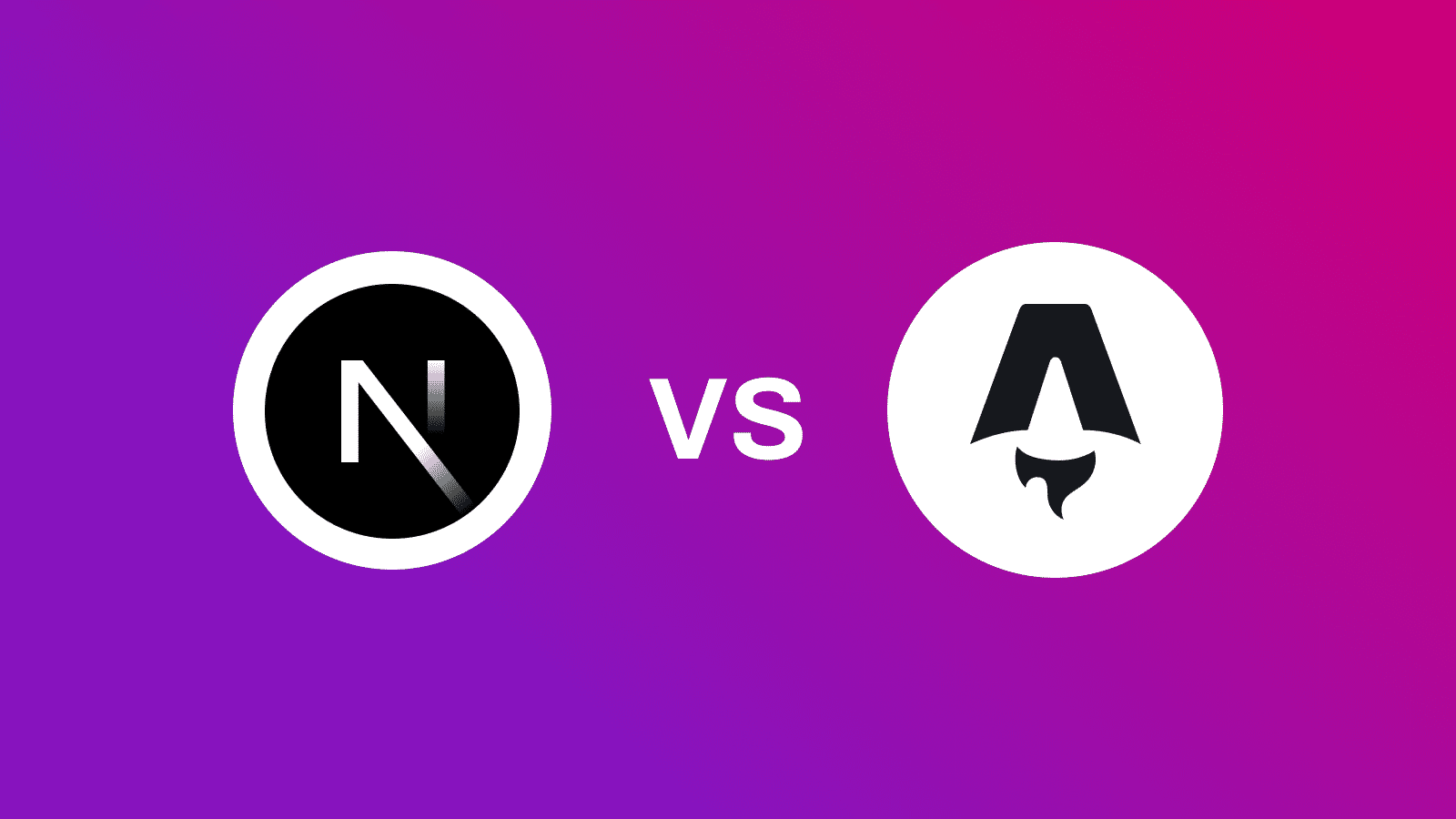
Looking for a quick answer? Here’s what you need to know:
Pick Astro if:
- You’re building content sites (blogs, docs, marketing)
- You want a framework that’s easy to learn and use without extensive JavaScript experience
- You want minimal JavaScript
Pick Next.js if:
- You need complex web apps
- You’re building highly interactive features
- Your team knows React well
| Feature | Astro | Next.js |
|---|---|---|
| Best For | Content sites | Web apps |
| JavaScript | Zero by default | 40KB minimum |
| Learning Curve | Easy (HTML-first) | Medium (React needed) |
Big names using each:
Want to start building? Here’s how:
# Astronpm create astro@latest
# Next.jsnpx create-next-app@latestCore Concepts
What is Astro?
Astro is a web framework that makes websites FAST. It does this by removing JavaScript you don’t need.
Here’s what makes it different:
| Feature | How It Works |
|---|---|
| Zero JavaScript | Ships plain HTML by default |
| Island Architecture | Loads JavaScript only where you need it |
| Framework Support | Use React, Vue, or Svelte components |
| Content Focus | Write in Markdown and MDX out of the box |
Think of Astro’s “islands” like small power stations. They only turn on when someone needs them. Everything else? Just plain, fast HTML.
Out of all the tools I’ve used in the past ten years, Astro is the one that makes me most excited about where web development is going. - Brian Holt
Want to mix different frameworks? No problem:
---import SvelteNav from './Nav.svelte';import ReactPost from './Post.jsx';import VueFooter from './Footer.vue';---
<SvelteNav client:load /><ReactPost client:load /><VueFooter client:load />What is Next.js?
Next.js supercharges React apps. Built by Vercel, it helps you build React apps faster and better.
| Feature | What It Does |
|---|---|
| Server-Side Rendering | Makes pages load fast, helps with SEO |
| Code Splitting | Ships only what each page needs |
| File-Based Routing | Files = URLs |
| API Routes | Build backend APIs right in your app |
Think of Next.js as a powerful tool for building highly interactive web applications. It’s the go-to choice for big names like TikTok, Twitch, and Hulu when they need to:
- Update content in real-time
- Check who users are
- Show different content to different users
- Keep track of complex data
How They Compare
Let’s look at the key differences between Astro and Next.js:
1. Page Loading Methods
These frameworks handle content in totally different ways:
| Feature | Astro | Next.js |
|---|---|---|
| Default Output | Plain HTML | JavaScript Bundle |
| JavaScript Loading | Only where needed | Full page hydration |
| Component Handling | Selective hydration | Complete hydration |
| Build Output | Static / Hybrid / Server | Static / Hybrid / Server |
Think of it this way: Astro is like picking items from a menu (you only get what you order), while Next.js serves the whole buffet (whether you’re hungry or not).
That’s probably why Trivago picked Astro for their content-heavy pages, but Twitch went with Next.js for their interactive features.
2. Working with each framework
Here’s what you’ll get with each:
| Feature | Astro | Next.js |
|---|---|---|
| Learning Curve | HTML-first approach | React knowledge needed |
| Framework Support | Multiple (React, Vue, Svelte) | React only |
| Development Tools | Focused (and growing) | Rich ecosystem |
3. Getting Data
Let’s look at data handling in both frameworks:
| Method | Astro | Next.js |
|---|---|---|
| Static Data | Built-in Markdown/MDX support | getStaticProps or generateStaticParams |
| Dynamic Data | Server endpoints | API routes |
| Data Updates | Build-time & Real-time | Build-time & Real-time |
| API Integration | Built-in API routes | Built-in API routes |
4. Using Components
Components work differently in each framework:
| Feature | Astro | Next.js |
|---|---|---|
| Component Format | .astro files | .jsx or .tsx |
| Framework Support | Multiple (React, Vue, Svelte) | React only |
| Styling Options | Scoped CSS, Tailwind, CSS Modules | Scoped CSS, Tailwind, CSS Modules |
| Third-party Tools | npx astro add command | NPM packages |
| Code Splitting | Automatic per component | Automatic per page / server component |
Best Uses
Let’s break down which projects work best with each framework:
When to Use Astro
Astro can do almost anything that major frameworks like Next.js and SvelteKit, etc., can do. It’s so powerful, it’s so flexible, it’s so simple. - James Q Quick
Astro shines when you need speed and content delivery:
| Project Type | Why It Works |
|---|---|
| Blogs | No JavaScript out of the box, Markdown ready |
| Docs Sites | Fast loading, organized content |
| Marketing Pages | Light JS, ranks well in search |
| Small Shops | Static pages with optional interactions |
| Portfolios | Works with many frameworks, optimizes images |
What makes Astro stand out:
- Starts with zero JavaScript
- Adds interactivity only where needed
- Handles content right out of the box
- Plays nice with your favorite UI tools
Astro ships ZERO JavaScript by default. It only adds JavaScript where you need it.
Think about building a blog with Astro: Your articles load as pure HTML. JavaScript loads ONLY for things like comments.
When to Use Next.js
Next.js has made it easier for us to scale and build on the Web with fewer people–there’s only one of us, and we’re putting our sites in front of some of the world’s largest brands. - Adham Foda CTO KidSuper
Next.js powers bigger, more complex projects:
| Project Type | Why It Works |
|---|---|
| Big Shops | Live inventory updates, price changes |
| Social Sites | Smooth navigation, instant updates |
| Dashboards | Handles complex data, API hookups |
| SaaS Products | Server rendering, built-in API tools |
| Big Business | Mix of rendering types, smart code loading |
What makes Next.js stand out:
- Supports server-side rendering
- Optimizes performance with automatic code splitting
- Manages images
- Controls page routing
Next.js includes JavaScript on every page. But don’t worry - it splits the code automatically to keep things fast.
Think about building a blog with Next.js: Pages load with JavaScript included, making navigation between posts instant.
Wrap-up
When deciding between Astro and Next.js, consider your project’s needs. Astro is ideal for content-heavy sites that require less JavaScript, while Next.js is better suited for highly interactive web applications that demand more dynamic capabilities.
Both tools keep getting better at what they do. Your pick? It comes down to what you’re building in 2024.


